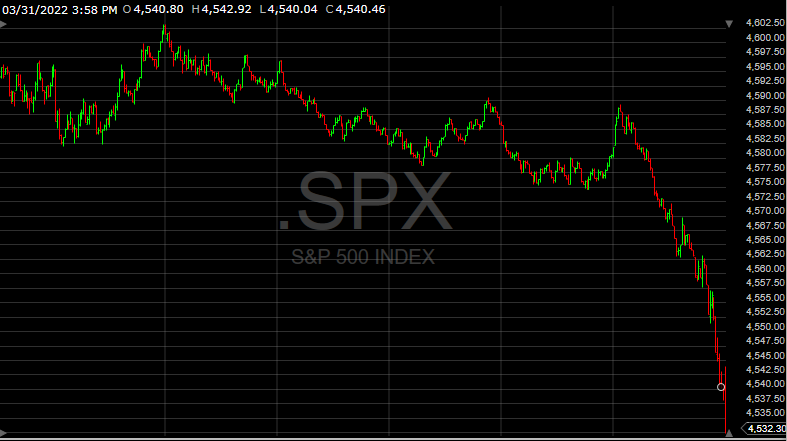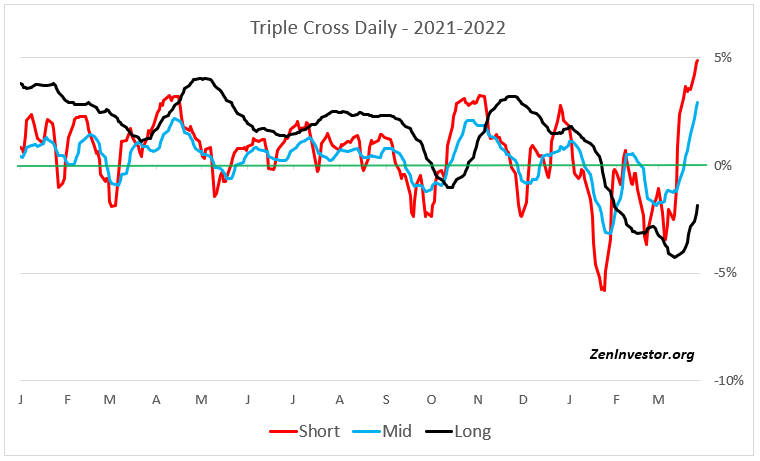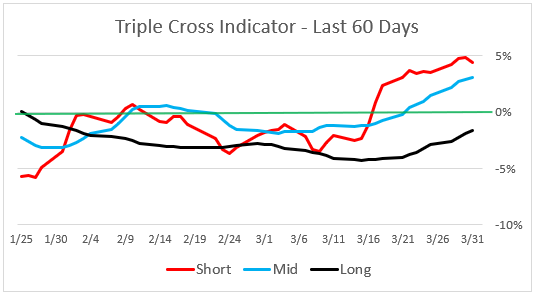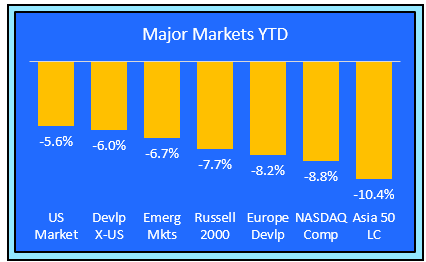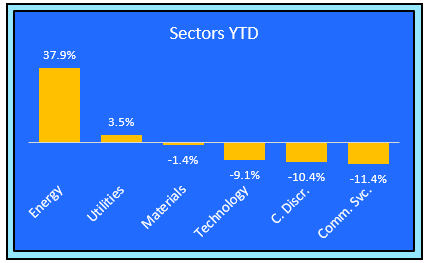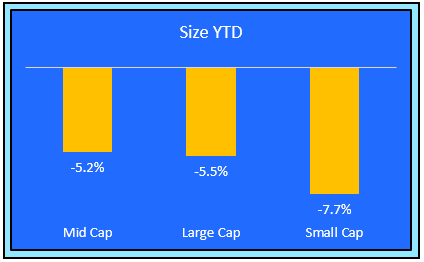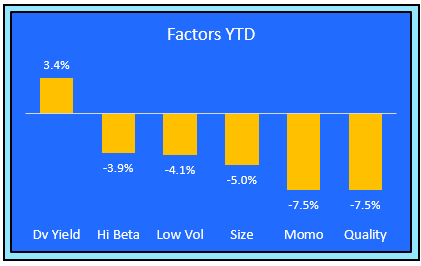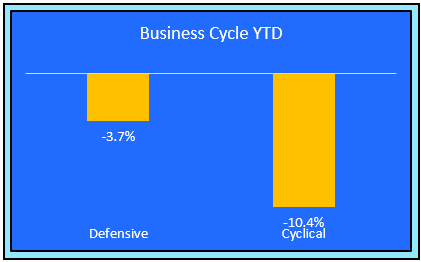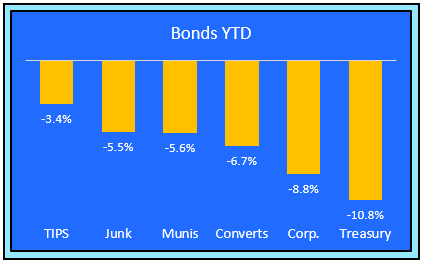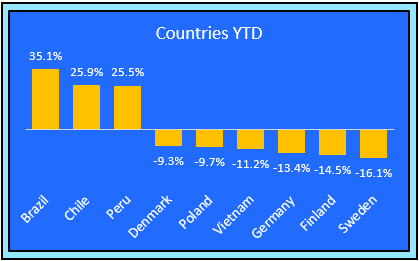Market Recap - Follow the Money is a series of brief, information-rich posts that I will publish periodically but not on a fixed schedule. I rely on charts to do the heavy lifting and I keep my commentary to a minimum.
If you're like me, you prefer to visualize facts and figures rather than reading about them in a long article. That's why I use charts and tables instead of dull, tedious prose. I also like to keep things as simple and on-point as possible.
Chart 1. S&P 500 last hour nosedive
After rallying for 9 of the last 11 days, the S&P 500 went from down -13% to down just -3.4% and the bulls were on their way to making a fresh new high. Then came a minor hiccup on Wednesday, followed by a last-hour swoon on Thursday.
Chart 2. Overbought and ripe for a fall
The 9 day rally left the market vulnerable for a pullback, as this chart shows. It tracks three separate moving average crossovers - short, mid, and long-term. The red (short-term) line hadn't been this high since June 2020, as the market was roaring higher after a 33% Covid-driven plunge.
Chart 3. Still overbought
After Thursday's nosedive the market still looks overbought to me.
Chart 4. Major Markets
I divide the global equity market into 7 segments - U.S. Total Market, U.S. Small Cap, NASDAQ, Foreign Developed, Europe Developed, Asia Large Cap. and Emerging Markets. As with all the charts, I show the year-to-date return. You can follow the money as it moves among these seven segments.
US Markets have taken the lead relative to non-US developed and emerging markets. Most of the global markets are down YTD except for some South American commodity-exporting countries (see the last chart for details).
Chart 5. Market Sectors
Of the eleven primary market sectors, this chart shows the top three and bottom three performers. I do it this way to keep things simple.
Money has been flowing out of tech, consumer discretionary, and communications services, and into energy, utilities, and materials. This trend will probably continue as long as there is uncertainty caused by the Russia-Ukraine war. Demand for oil & gas remains high, the global economy is taking a hit to growth. and inflation will continue to rise until energy prices begin to break down.
Chart 6. Styles - Growth vs. Value
After slightly underperforming growth last year, value is where the money is flowing. I see this as another durable trend. Growth has been hit hard by the slide in tech stocks this year.
Chart 7. Size
Small caps are still lagging. After underperforming last year, they are struggling to keep up this year. Mid caps were almost tied with large caps last year, and the are in the lead this year. The flow of money from large caps to mid caps looks like a durable trend.
Chart 8. Factors
There are more than 100 factors to choose from, so I had to cut the list to just six, in order to keep this chart reasonably easy to digest. Quality is getting pummeled this year after a stellar 2021. Mean reversion at work.
The top performing factor so far is dividend yield. I'm not sure about the durability of this trend, because rising bond interest rates will begin to compete with dividends at some point.
The bottom performer is Quality. This factor includes companies with strong and growing earnings, and growth is at least temporarily out of favor.
Chart 9. Sensitivity to the business cycle
In this chart I divided the market sectors into two groups - those that respond more vigorously to the changing phases of the business cycle (cyclical), and those that respond less vigorously (defensive).
With the economy still in growth mode, cyclical stocks should do better than defensive stocks. That hasn't happened yet this year, and maybe the market is sending a signal that the economy isn't as strong as many would like to believe.
The flow of money away from cyclicals and into defensive looks durable.
Chart 10. Bonds
I think it might be interesting to watch how the various flavors of bonds react to Quantitative Tightening. So far it looks like Treasury bonds are seeing the most outflows. That's understandable, given the sharp rise in the 2-yr and 10-yr rates.
Keep an eye on junk bonds, because they are especially vulnerable to an economic slowdown. If they continue to lose momentum, the risk of recession will increase.
Chart 11. Countries
There are 50 countries that are represented by ETFs. Here are the top and bottom performers YTD. It looks like South America is having a resurgence this year, while Europe is struggling with geopolitical issues and heavy sanctions - both imposed and threatened.
I removed Russia from this chart because their stock market is essentially closed to outsiders. At last count, RSX - the Russian ETF - was down by 79% and falling.
Final thoughts
We are now a quarter into 2022 and the trends we have established thus far will probably continue as long as the dark cloud of war, and all the uncertainty it brings with it, remains in place. By keeping an eye on money flows among these asset categories, you can gain some insight into what could be a durable trend, and what's just noise.
The trends that look the most durable to me at this time are value vs. growth, mid cap vs. large and small cap, defensive vs. cyclical, and commodities - especially energy - vs. tech.
European and Asian economies seem more vulnerable to the fallout from sanctions against Russia. There is a chance that Europe may slip into a recession later this year, and some Asian countries may follow after that.
The US will likely avoid a recession this year, but the picture may change in 2023.

